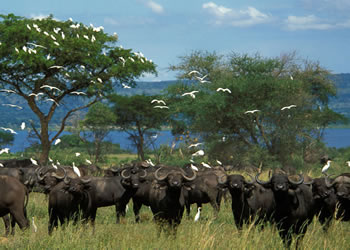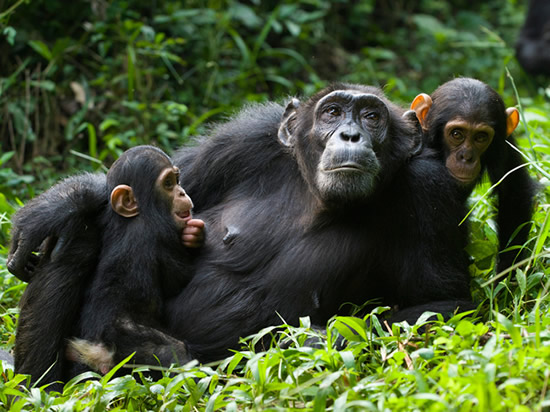Kibale Forest National Park: A Premier Destination for Chimpanzee Trekking
Nestled in the lush landscapes of Uganda, Kibale Forest National Park stands as a beacon for wildlife enthusiasts and adventure seekers alike. Renowned for its remarkable biodiversity, this pristine sanctuary is most celebrated for offering one of the world’s most thrilling and intimate chimpanzee trekking experiences. With over 1,500 chimpanzees calling its verdant expanse home, Kibale offers an unparalleled opportunity to observe these fascinating primates in their natural habitat.
Immersive Chimpanzee Trekking Adventures
Chimpanzee trekking in Kibale Forest National Park is not just an activity; it’s an immersive journey into the world of these remarkable creatures. Guided by experienced rangers, visitors traverse the dense forest canopy in search of the park’s chimpanzee families. The trek not only allows for close encounters with chimpanzees but also provides a deeper understanding of their behaviors, social structures, and the conservation efforts vital for their survival. The thrill of hearing a chimpanzee call echoing through the forest, or the sight of a young chimp swinging from the trees, creates memories that last a lifetime.
Biodiversity Beyond Chimpanzees
While the chimpanzee trekking experience is the highlight for many, Kibale Forest National Park boasts a wealth of biodiversity. Its 795 square kilometers are a haven for 13 primate species, including the red colobus monkey, the rare L’Hoest’s monkey, and the grey-cheeked mangabey. The park’s rich ecosystems also support over 375 species of birds, making it a bird watcher’s paradise. From the forest floor to the canopy, Kibale is alive with wildlife, offering endless opportunities for discovery and connection with nature.
Sustainable Tourism and Conservation
Kibale Forest National Park is at the forefront of sustainable tourism and conservation efforts in Uganda. The park’s management works tirelessly to ensure that chimpanzee trekking and other wildlife experiences are conducted in a way that respects the natural environment and contributes to the conservation of its inhabitants. Visitors play a crucial role in this by adhering to guidelines designed to minimize human impact and support conservation funding through their park fees.
Plan Your Visit
A visit to Kibale Forest National Park is a journey into the heart of Africa’s natural beauty and biodiversity. Whether you are drawn by the allure of chimpanzee trekking or the promise of exploring one of Uganda’s most diverse ecosystems, Kibale offers an adventure that is both profound and personal. To make the most of your experience, it is advisable to plan your trip with a reputable tour operator, ensuring that your adventure aligns with the principles of responsible and sustainable tourism.
Embark on a journey to Kibale Forest National Park and discover the magic of chimpanzee trekking amidst Uganda’s breathtaking natural wonders. This is not just a trip; it’s an encounter with the wild heart of Africa, promising moments of awe, learning, and unforgettable encounters with our closest relatives in the animal kingdom.
Key Species of Birds
Other Wildlife
Kibale has a well-established Chimpanzee-tracking program with a high success rate. Other primates that may be found on these guided walks include Guereza Colobus, Olive Baboon, Grey-cheeked Mangabey, L’Hoest’s Gentle ( Blue) and Red-tailed Monkeys is more likely to be found in open areas adjacent to the forest. You may find evidence of Elephant, Bush Pig and Bufallo along the trails, whilst Bushbuck, Blue, Harvey’s and Peter’s Duickers are other shy inhabitants of the forest interior. The guided night walks are also rewarding: Potto, Spectacled Demidoff’s and Thomas’s Galagos, Lord Derby’s Anomalure, African Civet and Common Genet are all possible.
Other interesting mammals from the list of over 60 species include Ichneumon, Banded and Marsh Mongooses, Alexander’s Cusimanse, Swamp Otter, Retell ( Honey Badger ) and African Palm Civet. Although Golden Cat, Serval, Lion, Leopard, Warthog, Giant Hog and Hippopotamus are recorded from the park, they are unlikely to be encountered in the Kanyanchu area. Sitatungas are known from Bigodi Swamp but are infrequently seen. The spectacular and beautiful Rhinoceros Viper is fairly common here but is, unfortunately, less often found alive than as a road-kill.
Accommodation
The best place to spend the night is in Primate Lodge Kibale. Within a short period different types of accommodation will be available, including modern bandas, luxury tents and a comfortable Sky Tree House. The lodge is located in the middle of the forest, exactly where you start the chimp tracking from. A charming restaurant, bar and fire place will make sure you will spend the evenings pleasantly.
Mantana Luxury Tented Camp located in the middle of the forest. Bush type accommodation and quite comfortable.
Ndali Lodge a luxury accommodation with thatched cottages overlooking a crater lake.
The Rwenzori View Guesthouse located in Fort Portal approximately 30 km from the forest. Comfortable, middle class rooms with or without private bathrooms are available.
The park offers very affordable chimp tracking. Groups (limited to 6 people) leave daily at 8:00 am and 3:00pm; the walks last about 3 hours. The highly recommended night walks depart from Kanyanchu Visitor Centre at 7:30 pm (book in advance). Bring your torch!
Facilities at Bigodi include; an observation tower and a boardwalk that traverses the papyrus beds. The path and boardwalk may be flooded and muddy after heavy rain and gumboots are recommended. They can be hired at the visitor Centre. The walk is about 4 km in length, taking 3-4 hours at birding pace. With all proceeds from eco-tourism going back into the community, this is a conservation project well worth supporting.
Access
Take the road from Fort Portal to Kamwenge, which commences near the bridge over the Mpanga River in Fort Portal and is well signposted. Turn left at the junction 12 km from Fort Portal and follow signpost for a further 24 km to Kanyanchu Tourist Centre.
Forest Regulations
- Please note that his is not a Zoo so it is a tropical rainforest and sightings depend on factors such as time of the day fruit availability, weather and how quite the primate group is.
- The maximum number of people in a group is 4 visitors per guided walk
- The maximum time allowed with the chimps is one hour, however, the time might be shortened under the guides discretion to eliminate stressful situations for the chimps
- When trekking you are advised to remain in a tight group and follow the guides’ directions at all times.
- Please remain at a distance of 8 meters from the chimps or the distance that your guide recommends
- Under no circumstance shall you chase while they descend or to or walk on higher ground.
- You are advised not to enter the forest if you are sick as this can put the animals at serious risk
- Please refrain from eating near the chimps and other primates
- Please do not shout in the forest
- It’s advisable to wear long boots that cover your toes and long trousers as there are red ants and slippery trails, also carry along water proof clothing in the rainy season.
- Children under 15 years are not allowed to view the chimps for safety reasons.
- If you need to urinate please do so off the trail system.
- If you need to defecate, please do so off the trail system and bury all in a whole all waste.
Day 1: Transfer to Bwindi national park (8-10hrs)
Start off early from Kampala heading to Bwindi impenetrable national park. We head south west of Kampala; stop in Masaka to see the equator and in Mbarara for lunch. Continue to Bwindi forest, a home to Approximately 480 mountain gorillas/half of the world;s mountain gorilla population . Dinner and overnight at Mahogany springs lodge/ Bwindi forest lodge/ Buhoma lodge/Bwindi community camp.
Day 2: Gorilla trekking Adventure and Batwa walk (Pygmies)

Get up early, take breakfast and head to the park headquarters for briefing about the gorillas. Head for the thick jungles of Bwindi as you trek searching for the gorillas. This can take you half a day or more spend an hour with the gorillas. In the evening you can take a village walk around Buhoma and find out about the Batwa pygmy natives, also shop from available curio shops. Dinner and overnight at the lodge (day 1).
Day 3: Transfer to Queen Elizabeth national park tour
Have morning breakfast and transfer to Queen Elizabeth national Park (5 hrs) via the Ishasha route. On your way you will see the tree-climbing lions alongside Uganda Kobs, buffalos. Finally when you enter the park begin with a game drive to Mweya Peninsular. Proceed to the crater lakes region. Here there are several saline crater lakes. Check out how the locals mine salt. Overnight in Mweya safari lodge/Katara lodge/Enganzi lodge/ Park view lodge.
Day 4: Game drives and launch cruise – Queen Elizabeth National park

After breakfast go for an early game drive to Kasenyi plains where you will spot black and white colobus, bush buck, Uganda Kob, topi, Defassa waterbuck, and Cape buffaloes and many bird species. Head back to lodge for lunch then in the evening go for a launch cruise on Kazinga channel (2hrs) along lake George-lake Edward, come eye-eye with yawning hippos, crocodiles and over 611 bird species. Return to Return to the lodge for dinner and overnight.
Day 5: Chimp tracking in Kyambura Gorge & transfer to kibale forest national park
This morning take your breakfast then head straight for chimpanzee trekking in Kyambura Gorge at exactly 8:00am. Did you know we have a lot in common? So spend some time with them to learn more. There are more diverse primates also mainly Black and white Colobus monkeys and other animals like antelopes, hyenas in the middle of savanna grassland. This gorge has many bird species. You will then transfer back to the lodge for lunch lodge and then depart for kibale forest national park. Dinner and over night stay at Primates Lodge/ Crater safari lodge/ Kibale forest camp.
Day 6: Chimp tracking in Kibale Forest and visit to Bigodi swamp

Wake up early, take breakfast and transfer to the national park headquaters at Kanyanchu for briefing before the start of the trek. This can take you half a day. While trekking the chimpanzees, you will also encounter other animals such as the blue monkeys, L’Hoest monkey, grey checked mangabey, red colobus, blues and pottos. Other animals involve forest elephants unique from the common type, giant forest hogs and an impressive tree species. Later take a nature guided walk to Bigodi swamp sanctuary, a good site for birders. The Great Blue Turaco can easily be spotted among the other bird 137 species. Dinner and overnight at the lodge (day 5).
Day 7: Transfer to Murchison Falls
Here you will wake up very early, take breakfast and check out of the lodge for Murchison falls national park which will take you roughly 7-8 hours drive. You will have stop over at Zziwa rhino sanctuary a home to the orphaned Rhinos in Nakasongora via luwero traiangle with spectacular views of Lake Albert and Rwenzori mountains having lunch en-route. You will then drive straight away to the Top of the falls, quite a sight to appreciate the beauty of the River Nile and the falls. Dinner and overnight at Paraa safari lodge/ Red chilli camp/ Nile safari camp.
Day 8: Game drive in the delta circuit

Early morning go for a game drive in the Northern Nile delta circuit and check out for wildlife browsing in the open savannah grasslands such animals include leopards along the leopard track, the Jackson’s hartebeest, large concentrations of Uganda Kobs because of the many breeding grounds and large families of the Defassa waterbuck, together with giraffe herds, groups of the dainty oribi and buffalo herds. The high supply of Kobs called for an unavoidable prides of lions to the delta too. The delta also attracts birders with specials like the Abyssinian ground hornbill, shoebill (herons, waders and egrets around small pools of water) Senegal thickknee and Denham’s bustard. What’s not there? In the evening head out for a launch trip on the famous Nile River and value God’s creation of the Murchison Falls, the largest crocs, Hippos and elephants playing in the water. After such a lovely encounter retire to your lodge at Sambiya Lodge/ Red Chili camp/ Nile Safari camp.
Day 9: Chimp tracking in Budongo Forest
After having a good breakfast, let’s head for a little close tour with our next of kin in the animal kingdom- the chimpanzees in Budongo forest. The forest harbors the biggest chimp population in Uganda -800 of them! So much we have in common with these creatures. Also you get to see other allied relatives like the black and white colobus, vervet monkey, potto and blue monkey. After wards take your lunch and drive straight to Kampala.
Day 10: Departure
Drive back to Kampala after breakfast.
End of Tours
Drive back to Kampala after breakfast.
End of Tours

